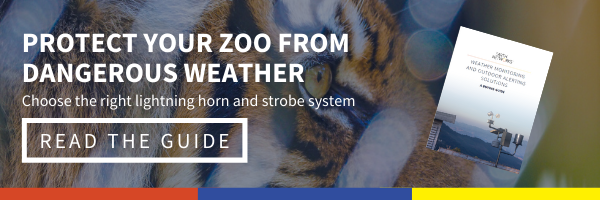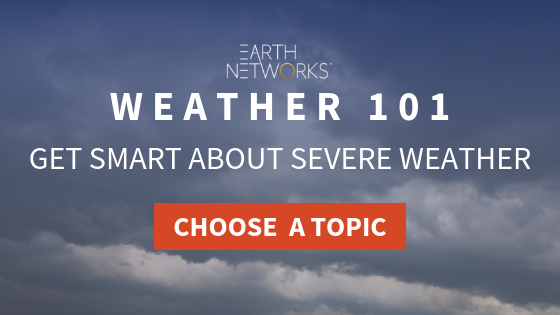Zoos and Bad Weather: 4 Weather Management Tips for Zoos
- Oct 04, 2019
Zoos and bad weather don’t mix. Here are four weather management tips for zoos to help keep your staff, visitors, and animals safe.

If you own or work at a zoo, we bet that most of your facility is outdoors. While that makes it a great place for visitors who want to get some fresh air, it also leaves them, your employees, and your animals vulnerable to the elements.
Protecting everyone at your zoo from inclement weather starts with a solid weather safety plan and the right tools to carry it out.
While extensively planning for severe weather for your entire zoo facility seems intimidating, there’s always a place to start. We recommend starting your zoo and bad weather safety planning with the following four tips:
- Install a Severe Weather Alerting System
- Use Wet Bulb Globe Temperature (WBGT)
- Install Climate-Controlled habitats
- Ensure Proper Draining Systems
1. Severe Weather Alerting Systems for Zoos
Your first concern for severe weather at your zoo should be safety. Every day weather events like thunderstorms can cause extensive damage to structures, humans, and animals. That’s because thunderstorms come with threatening conditions like high rainfall totals, lightning, and gusts of wind.

That’s why we always recommend zoos install a severe weather alerting system. While there are plenty of different warning tools on the market today, you should evaluate them based on the following three points:
- Source of weather/lightning data
- Alerting methods
- Ease of use
Data Sources
Since most dangerous storms come with lightning, zoos should rely on alerts based on lightning data. However, not all lightning data is created equal.
For example, lightning “prediction” tools may sound like the best option but they’re not. The word prediction implies that you’ll know before the lightning strikes; giving your employees the most time to move guests and animals to safety.
However, the term lightning prediction is misleading.
The term lightning prediction is misleading. Lightning prediction systems have high rates of false and missed alarms. Share on XLightning prediction horns and other tools send out alerts when they pick up any electrostatic activity in a given range. This means that there are a lot of false alarms and missed alarms.

The only way to protect people and animals before a thunderstorm or rogue bolt from the blue arrives at your facility is with total lightning detection.
Lightning detection is the tried-and-true scientific process of using equipment that measures pulses in electric fields to pinpoint lightning strikes and determine where storms are headed. Total lightning detection is the process of measuring all lightning strikes: Both cloud-to-ground and in-cloud.
Total lightning detection networks track lightning strikes around the world, understanding when thunderstorms form, where they’re moving, and how fast they are moving. This gives your zoo unparalleled weather intelligence and the most time to get people and animals out of harm’s way.
Alerting Methods
Once your zoo is using total lightning detection data for severe weather protection, you’ll need to use that data to alert key stakeholders.
Alerting methods are different for every zoo. That’s why it’s important to use a thunderstorm alert provider that has a variety of trustworthy alerting methods. Some of the most popular alert types include lightning horn and strobes, proximity alerts delivered by email or text, and visual alerts on a weather map.
Ease of Use
Your key stakeholders can’t receive inclement weather alerts if those alerts are difficult to obtain or understand!
Whatever alerting method you choose, it’s important that these alerts are derived from a total lightning detection network and that they are automatically sent. Automatic alerts take the risk of human error out of the equation.
Another usability issue comes with how the alerts are delivered. If your zoo wants to use mobile phones for severe weather alerting, it’s important that all employees have the same easy-to-use application. Commercial weather applications like Sferic Mobile ensure that everything is streamlined and consistent across your zoo organization.
2. Use Wet Bulb Globe Temperature
Thunderstorms aren’t the only major bad weather threat zoos must contend with.

On the flip side, heat can also be a big problem for both animals and guests. While a warm summer day seems like the perfect time to visit, your guests may encounter heat stress and suffer from resulting injuries.
It’s important you know the chance of heat stress impacting your guests and employees throughout any given day, but how? Most people may assume that just looking at the temperature is the right way to go. However, there is a lot more that goes into how hot it actually feels than just the temperature! Heat Index is a step in the right direction, but it still isn’t the most accurate measure on the amount of heat stress on the human body.
The best measure of how hot it really is is wet bulb globe temperature (WBGT). WBGT is an apparent measurement used to estimate the most accurate level of heat stress in direct sunlight.
By installing a weather station with WBGT readings, your zoo can understand how hot it will really be for your staff, guests, and animals on any given day. That way, you can prepare for dangerously hot days with water refilling stations, tents for shade, and reminders for guests to take a break every once in a while.
3. Use Climate-Controlled Habitats
Understanding WBGT often isn’t enough to keep your furry (or scaly, or feathery!) friends at the right temperature. That’s why it’s important for zoos to promote animal well-being with climate-controlled habitats.
Tools that aid with climate-controlled habitats include heaters, mobile cooling units, and dehumidifiers. Modern climate control systems have drastically improved the lives of animals in captivity, even when it comes to zoos and bad weather.
Fiona the Hippo

Advanced climate-controlled habitats can also protect the lives of sick or otherwise compromised animals. For example, Fiona the hippo at the Cincinnati Zoo was born six weeks premature. She was underweight, couldn’t nurse, and didn’t stand much chance of survival. To make matters worse, she was born in the middle of winter. Within a half hour of her birth, her temperature dropped dangerously low.
The staff moved Fiona to a makeshift intensive care unit with a controlled climate of 98 degrees to try and get her temperature up. Thankfully, it worked. Fiona is now healthy and less importantly, a celebrity. She has 230,000 followers on Facebook!
Climate Control
This is just one of the many stories of how critical climate control can be for zoos. If you already have climate-controlled habitats; that’s great, but it’s important you regularly check that they’re working. It can be a major investment, but it’s worth it to know that your enclosures closely mimic the natural habitats of their residents.
When you can control the habitat of your animals and offer them a safe place to go during bad weather, you’re helping them by reducing their susceptibility to diseases and improving their chances of successful breeding. Way to go!
4. Ensure Proper Drainage
For our last zoos and bad weather tip, we recommend thinking a little outside the enclosure. As long as your zoo isn’t located in a desert, you must be ready to deal with rainwater. It doesn’t matter if you are in an area that has a predictable wet season or one in which flash flooding is an issue, you must have a drainage plan to ensure safety and overall structural stability throughout your zoo.

Every facility on the planet should have a proper drainage system that can handle anything Mother Nature can cook up, however it’s a little complicated for zoos. Think about it: You have lots of different areas that, when flooded, will pose different threats and challenges. Parking lots, exhibits, and walkways all have unique needs when it comes to drainage.
Zoo water management issues are complex because the amount of storm water that gathers will differ along with the type of runoff. Runoff and floodwaters at zoos can contain chemicals from exhibit sanitations as well as the daily control of animal waste.
Parking lots and walkways will have a large amount of storm water runoff since rainfall will not be able to soak into the soil naturally. It’s important that you have the right drainage infrastructure in place to handle your zoo’s specific needs when wet weather approaches.
Zoos and Bad Weather
While some weather, like tornadoes, are always bad for a zoo, it’s important to remember that other “bad weather” conditions can actually be a good thing!

You know that different animals thrive in different weather conditions. That’s why it’s important to encourage guests to come visit even when the temperatures are hot or chilly, as long as they come prepared.
During warmer days, send out reminders via social media for guests to come with water bottles, wear light, loose-fitting clothing, wear sunscreen, and take breaks.
When it’s chilly out, recommend guests come out to see the animals with boots, hats, gloves, and plenty of layers. Hand warmers don’t hurt, either!
Do you have tips for zoos and bad weather? Let us know in the comments below or reach out on social media.
Zoo and bad weather question: Share on XYou can keep reading about the weather by visiting our Weather 101 Resource section.







